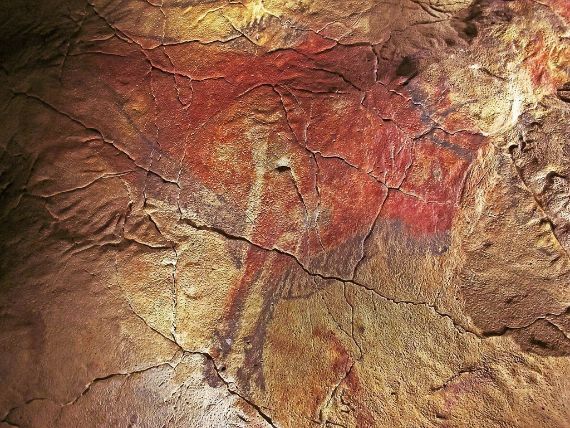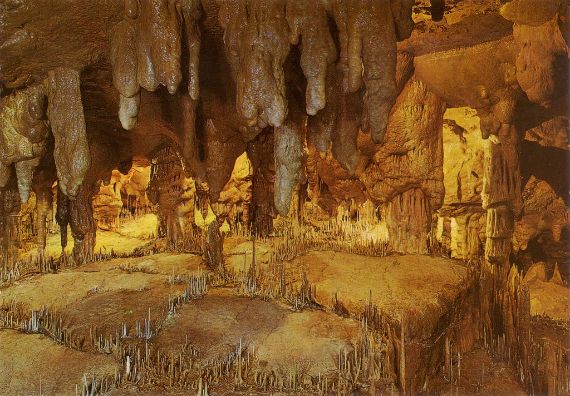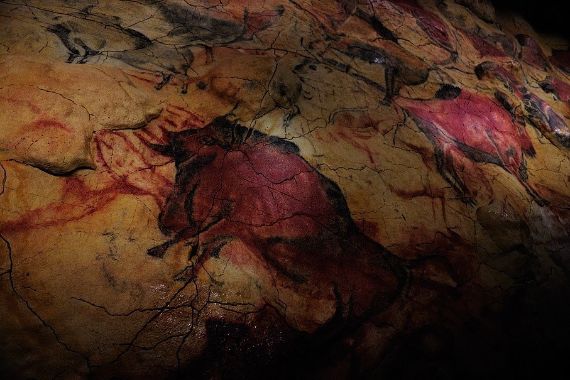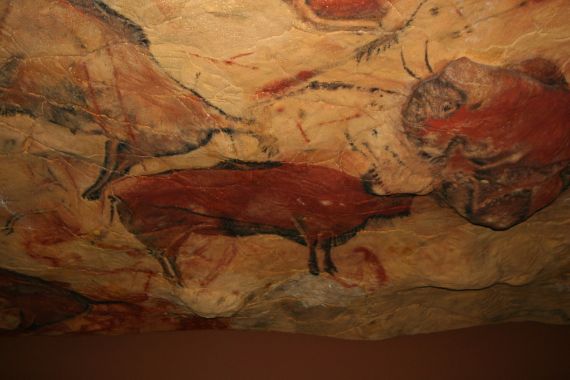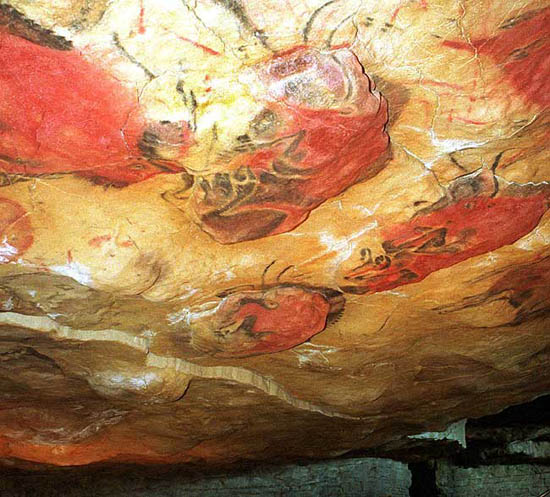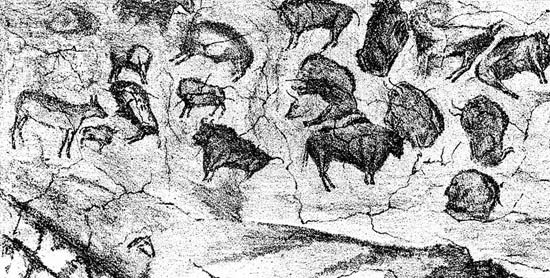Altamira cave in Spain (La cueva de Altamira) is a cave located in one of the hills that surround a nice valley where Santillana village is placed, in the province of Cantabria, in the north of Spain. Cantabria is one of the regions richest in archaeological finds from the Paleolithic era. 
This traveling site, cave of Altamira is a paleolithic cave art in northern Spain is the cave with the most important paleolithic rock art in Spain. Altamira cave is among many prehistoric caves that have been discovered in this area and one of the most well-known in the world. It is known for the dramatic history associated with its discovery. It has preserved multi–colored rock paintings from the late Paleolithic period (approximately 15-10 millennia BC. In 1985, UNESCO awarded it the title of a World Heritage Site.
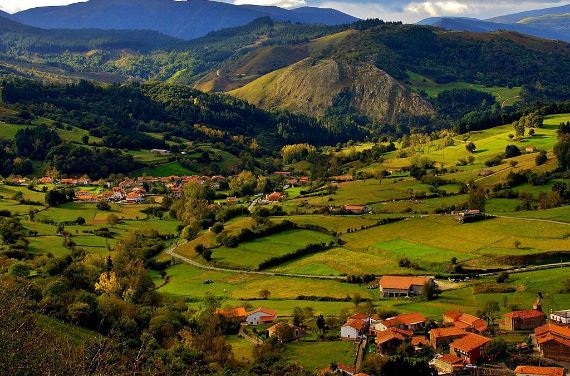 General information
General information
Cave of Altamira is famous for its Upper Paleolithic cave (Late Stone Age). They belong to the so-called Madeleine culture, which was spread over the territory of modern Germany, France, Belgium, Spain and Switzerland. In its ceiling there are nearly hundreds of paintings, mysterious signs, featuring drawings, polychrome rock paintings of wild mammals, human hands, Bison, horses, deer …both painted and engraved, which are the artistic expression of the inhabitants of the cave. People who lived at that time knew how to work bones, make flint cutters and arrowheads and also hunt mammoths, wild horses and reindeer, which were found in Europe at the end of the Ice Age.
How Altamira Cave Was Discovered
Altamira was the first cave in which prehistoric cave paintings were discovered. Around 13,000 years ago a rockfall sealed the cave’s entrance, preserving its contents until its discovery in 1868.
The land on which the cave is located was owned by the Spanish Grand Count Marcelino Sanz de Sautuola. He studied law, he was a passionate amateur archaeologist and was also interested in geology and biology. Everyone in the area knew the existence of a large underground cavity but did not attach much importance to it. Since ancient times, shepherds hid in it from the rain, hunters settled down to rest or for the night.
The discovery in 1868 was by chance by the hunter Modesto Cubillas Perez, caused by a nearby tree falling and disturbing the fallen rocks. His dog got stuck in a crevice and the owner, helping the dog to get out, found a grassy entrance leading into the ground.
10 years later, Sautuola visited the World Exhibition in Paris and got acquainted with the collections of artifacts of the Stone Age there. Returning to his homeland, he began to explore the cave and found in it the tools of labor of primitive people. But once, having entered the cave while walking, in 1879, the landowner’s (the Count’s daughter) 9-year-old daughter, Maria, visited the cave and saw colored spots resembling bulls on the stone vault. Maria drew her father’s attention to the hard-to-see multi-colored spots, which seemed to form the outlines of animals…pictures of buffaloes, bulls, horses, deer. It would seem that this is an amazing find, but that day was the beginning of misfortune for the family.
Sautuola correctly assumed that the drawings could have been made by people living in the Stone Age. The count Marcelino Sanz de Sautuola was an amateur archaeologist, and with further exploration of the Altamira cave, he and his friend an archaeologist from the University of Madrid, Juan Vilanova y Pierre, who was the author of the book “The Origin, Nature and Age of Man”, began excavating the cave and suggested that the drawings belong to the Stone Age. Both made a publication in the press with their research in 1880 and attributed the cave and its drawings to the Paleolithic era. However, public recognition did not come to them.
All the major specialists especially the French archaeologists of that time met with fierce opposition from the leading archaeologists of the time, perceived the news ambiguously and unanimously declared that this was a falsification and accused Sautuola and Vilanovay Pierre of forgery at a prehistoric convention held in 1880 in Lisbon. They did not want to believe in the existence of a perfectly preserved ancient rock art in the Altamira cave. Without even trying to visit the cave and thoroughly examine the discovered artifacts, they made many arguments and accused Sautuola of deliberately trying to mislead respected scientists.
The proud aristocrat suffered greatly from the injustice and barely endured the accusations and insults. He died 8 years later with the stigma of a deceiver.
In 1895, 15 years after his death similar rock paintings and the same drawings were discovered in other parts of the cave in France. All charges against the archaeologist Sautuola dropped and were forced to admit they were wrong and they managed to prove the correctness of the Spanish archaeologist in 1902. Finally, they agree that the drawings really belong to the Paleolithic era. The famous French archaeologist Emile Cartallac, considered an ardent critic of Sautuola, changed his point of view and publicly admitted his mistake. After that, Sautuola and his daughter Maria were declared the first to open the world to the art of people of the Stone Age.
The Altamira Cave consists of a series of rooms chambers, and twisting passages shaped like an S, 270 meters long. The main hall has a length of 18 m a ceiling height 2 to 6 m high. The paintings are located in the deep recesses of caves on the walls and on the ceiling of the main hall and in the corridors but a significant part of them are scattered throughout the rest of the cave. The beautifully preserved polychrome drawings amaze tourists and professional artists.
The drawings, the most important value of the cave, are made by the primitive people hands and special devices of natural dyes- with coal, ocher, hematite, kaolin, manganese and other natural colors. The drawing represents images of bison, buffalo, wild boars, horses, handprints and the outlines of the palms of prehistoric artists are visible.
Ancient artists used the natural contours of the wall to create a three-dimensional effect, possibly due to their religious views of the world. In terms of the technique of the image, similar drawings and images were found in the caves of Scandinavia and Northern Italy.
Today the Altamira cave is known all over the world. Altamira Cave is a cultural landmark in the history of mankind, became a World Heritage site in 1985.
Scientists have not yet come to a consensus on how many artists participated in the creation of the drawings. In addition, species does not appear at all in the cave paintings whether the images were the realization of a single plan, or whether the figures of animals in the cave accumulated gradually, from generation to generation as drawings of humans were rare and were usually schematic. The study of the cave and its petroglyphs allowed scientists to draw a conclusion and collect more data on our species and the journey we underwent to get to where we are currently, and hints at where we could be in the future.
Altamira Cave were being damaged that developed across Europe, from the Urals to the Iberian Peninusula, from 35,000 to 11,000 BC. These caves are well preserve, because of their deep galleries, isolated from external climatic influences of wind and water. For a long time, the cave served only as a home for animals.
During the 1960s and 1970s, the paintings in the Altamira Cave were being damaged by the damp breath of huge numbers of visitors. Altamira was completely closed to the public in 1977, as a necessary measure to protect the magnificent artwork. A replica cave and museum were built nearby to allow traveling visitors to view the amazing artworks.
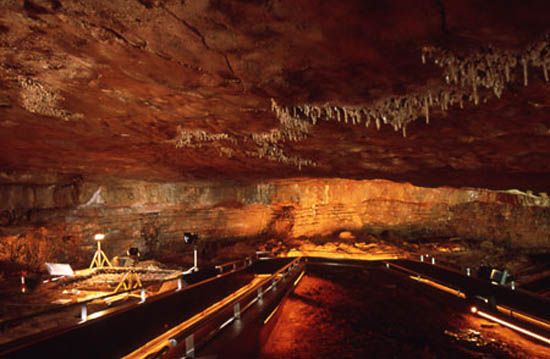

How to visit
Altamira cave is a masterpiece of human creative genius. The cave was visited by over 1,500 people a day. This led to the appearance of mold on the drawings from dampness. The Spanish authorities closed the cave for restoration in 1977 and reopened only in 1982.
Anyone who is interested in ancient history of mankind and the ancient world would consider it a great fortune to visit this cave, but now access to the unique cave is limited. In order to preserve the rock carvings of the precious evidence of ancient people, only a few people are allowed into the cave a day with a special pass. The Spanish authorities limited the number of tourists to 20 per day for this you need to obtain a special permit in a scheduled for 3 years in advance.
The line of visitors is scheduled for three years in advance. For those who do not have the patience to wait three years to look at the originals, exact copies of the rock paintings are on display at the Museum of Ancient History and Archeology in the seaside town of Santander, 30 km from Altamira Cave. Other museums have the exact copies of Altamira drawings are; the National Archaeological Museum of Spain in Madrid, the Deutsches Museum in Munich, as well as in Japan.
You may also be interested in;
Traveling to Spain Barcelona
Traveling to Spain Madrid
Things to do with kids in Madrid- Spain Holiday
Living in a Paradise: The Serra de Tramuntana of Mallorca, UNESCO World.
San Leucio Complex Caserta, Italian Unesco World Heritage Sites
Avila – Spain’s magnificent walled city
Notre-Dame de Chartres, Gothic Cathedrals, France
Mont-Saint-Michel France
Liverpool – Maritime Mercantile City – UNESCO World Heritage



















